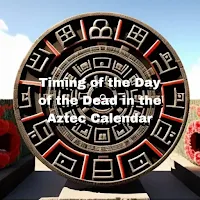When is the Day of the Dead in the Aztec calendar?
When is the Day of the Dead in the Aztec calendar?
The Day of the Dead, or Dia de los Muertos, is a deeply significant tradition in Mexican culture, originating from pre-Columbian civilizations such as the Aztecs. In the Aztec calendar, the festival corresponds to the ninth month, known as Miccailhuitontli, which typically falls around the end of October and the beginning of November in the Gregorian calendar.
Cultural Significance
For the Aztecs, death was not viewed as the end of life but rather as a continuation of the journey. The Day of the Dead was a time to honor and remember deceased loved ones, believing that they continued to exist in the afterlife. Offerings of food, water, and other items were made to nourish the spirits on their journey.
Connection with Nature and Agriculture
The timing of the Day of the Dead in the Aztec calendar also reflects the agricultural cycle. It coincided with the end of the harvest season, a time of transition and reflection as communities prepared for the coming months of winter. This connection to nature underscores the cyclical nature of life and death.
Rituals and Ceremonies
Aztec rituals during this time included cleaning and decorating gravesites, creating altars (or ofrendas) adorned with marigolds, candles, incense, and the favorite foods and drinks of the deceased. Skulls made of sugar or chocolate, known as calaveras, were also common symbols.
Blend of Indigenous and Catholic Traditions
After the Spanish colonization of Mexico, Catholic traditions merged with indigenous practices, leading to the modern-day celebration of Dia de los Muertos. Elements such as the use of marigolds, which were believed to guide spirits back to the living, and the construction of altars, reflect this blending of cultures.
Community and Celebration
Dia de los Muertos is a communal celebration where families come together to remember their ancestors, share stories, and celebrate life. Music, dance, and colorful costumes are common sights during the festivities, creating a vibrant and joyful atmosphere despite the solemn nature of the occasion.
In summary, the Day of the Dead in the Aztec calendar holds deep cultural and spiritual significance, rooted in a worldview that embraces the cycle of life and death. It is a time of reverence, remembrance, and celebration that continues to be honored and cherished by Mexican communities around the world.
FAQ Facts:
1. Q: When does the Day of the Dead occur in the Aztec calendar?
A: The Day of the Dead, or Dia de los Muertos, aligns with the ninth month of the Aztec calendar, typically around the end of October and the beginning of November in the Gregorian calendar.
2. Q: Why is the Day of the Dead celebrated during this time in the Aztec calendar?
A: The timing coincides with the end of the harvest season, symbolizing a transition from life to death and reflecting the cyclical nature of nature and agriculture in Aztec culture.
3. Q: What are some traditional Aztec rituals associated with the Day of the Dead?
A: Aztec rituals included cleaning and decorating gravesites, constructing altars adorned with offerings, such as food, water, and marigolds, and creating calaveras (sugar skulls) as symbolic representations of deceased loved ones.
4. Q: How has the celebration of Dia de los Muertos evolved over time, incorporating both Aztec and Catholic traditions?
A: After Spanish colonization, Catholic traditions merged with indigenous practices, resulting in a blend of rituals and symbols seen in modern Day of the Dead celebrations, such as the use of altars and marigolds.
5. Q: What is the significance of the Day of the Dead in Aztec culture?
A: The Day of the Dead is a time to honor and remember deceased ancestors, reaffirming the belief in the continuity of life beyond death and fostering a sense of community through shared remembrance and celebration.
